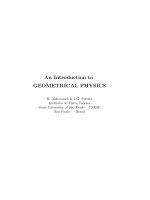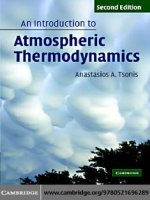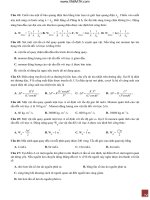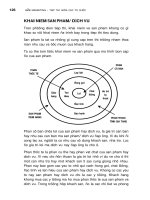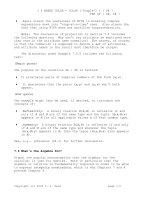An Introduction to Thermodynamics phần 6 docx
Bạn đang xem bản rút gọn của tài liệu. Xem và tải ngay bản đầy đủ của tài liệu tại đây (270.7 KB, 13 trang )
(14)
0
2
2
2
k
dN
df
N
=
→
0
2
2
0
2
2
0
2
2
0
2
2
2222
0
0
→→→→
=
−
−
=
∆
∆
=
NNNN
N
f
N
f
N
f
dN
df
( )
k
N
f
N =→
2
2
2
0
(
)
222
(15) 0 kNfN =→
(
)
(15a) 0
222
kNPN =→
(
)
(15b) 0
222
kcfc =→
7/10/07 3- 66
measurements, the following statement is put forth as a postulate: For all solutes that do not
dissociate upon dilution, the slope of fugacity against concentration, df/dN , at the origin is
2
finite and non-zero.
HENRY’S LAW. In 1803 William Henry proposed, on the basis of his measurements, that the
solubility of a gas in a liquid increases in proportion to the pressure of the gas. This result can
be easily derived from the dilute-solution postulate, which can be written
The number k is the slope at the origin, which will depend on the solute and on the solvent, and
the notation N !6 0 indicates that the solution is very dilute. (That is, as N approaches zero the
2 2
equation must become valid.) A derivative is, by definition, the limiting value for the ratio of the
changes in the dependent and independent variable or, in this case, the limiting value, as ∆N is
2
made small, of the ratio ∆f /∆N . But ∆f cn be written f - 0, for a small increment of fugacity at
2 2 2 2
the origin, and ∆N can similarly be written N - 0. With these substitutions, we write
2 2
Combining this result with equation 14, we obtain
or
For a very dilute solution the fugacity, and vapor pressure, of the solute are very small and
therefore the fugacity is equal to the vapor pressure.
This is Henry’s law. For dilute solutions the concentration, c , expressed as molarity or molality,
2
is proportional to the mole fraction, N , so Henry’s law may be written in the more general form
2
or
(
)
(15c) 0
222
kcPc =→
(
)
( )
B
B
BB
A
A
AA
ckfc
ckfc
222
222
0
0
=→
=→
BA
ff
22
=
B
B
A
A
ckck
22
=
( )
(16) 0,0
2
2
22 D
A
B
B
A
BA
K
k
k
c
c
cc ==→→
7/10/07 3- 67
The value of k depends on the solute, the solvent, the temperature, the units in which c is
2
expressed (mole fraction, molarity, or molality), and the units in which f or P is expressed
2 2
(usually atm, Pa, or torr). Small deviations from equation 15c may be observed at moderate
concentrations because the vapor is not ideal; large deviations may occur because the solution
may not obey equation 15b (or 15) in solutions that are not highly dilute.
An example of Henry’s law is provided by the human respiratory-circulatory system. Blood
entering the lungs is exposed to air containing approximately 0.20 atm oxygen, and it becomes
saturated, at this pressure, with oxygen. When the blood reaches the capillaries, the pressure of
oxygen in the surrounding tissues is less than 0.20 atm, so oxygen is given up by the blood to the
surrounding tissues. Meanwhile, the blood picks up carbon dioxide at a comparatively high
pressure in the tissues surrounding the capillaries and loses carbon dioxide in the lungs where the
partial pressure of the CO is comparatively low. Both gases are bound chemically within the
2
blood (with hemoglobin or as carbonates), but that equilibrium is controlled by the fugacity of the
free gas in the liquid phase, which is controlled in turn, through Henry’s law, by the partial
pressure of the gas in the surrounding medium (the air of the lungs or the fluids around the
capillaries.).
NERNST’S DISTRIBUTION LAW. When two solutions, containing the same solute but different,
immiscible solvents, are brought to equilibrium, the final concentration of the solute will generally
be higher in one solvent than in the other. However, the ratio of the concentrations remains
unchanged if more solute is added, provided the solutions are dilute.
Consider one solute distributed between two immiscible solvents, A and B (Figure 2). The
concentration of the solute in solvent A is c and the concentration of the same solute in solvent
2
A
B is c . From Henry’s law,
2
B
In order that the system be at equilibrium, the free energy of the solute must be the same in the
two solutions. This requires that the fugacity of the solute be the same,
and therefore
or
(17)
i
o
ii
Nff =
(
)
BABA
VVV +=
+
.I.Soln
7/10/07 3- 68
The ratio of the two Henry’s law constants, k /k , is also a constant, which is known as the
B A
distribution constant, or distribution coefficient, K . Nernst’s distribution law states that
D
for dilute solutions, a solute will divide itself between
two immiscible solvents to give a constant ratio of concentrations
(over a range of concentrations for which k and k are
A B
constant).
The distribution law is the basis of solvent extraction
procedures. Distribution coefficients are also important, for
example, in the storage of gasoline, which is a mixture of many
hydrocarbons. The storage tanks must be vented to the air and
consequently water vapor can condense in the tanks. The water
is not significantly soluble and simply sinks to the bottom of the
tank, where it might be expected to cause no trouble. However,
the blending of gasolines, especially for winter driving, requires a
carefully controlled percentage of the lighter hydrocarbons, such
as butane and pentane. Because these hydrocarbons are more
soluble than the heavier hydrocarbons in water, the water layer
becomes richer in light hydrocarbons and the gasoline becomes
slightly depleted in the lighter, more volatile compounds. The
effect is to make the gasoline lack cold-weather starting
properties if the fractionation is not properly compensated for.
IDEAL SOLUTIONS. Henry’s law states that, over the concentration range for which it is valid,
the fugacity, or vapor pressure, of a solute is proportional to the concentration of that solute.
The proportionality constant for each solute-solvent system must be determined by experiment.
In certain solutions the Henry’s law constant takes on a particular value — the value of the
fugacity, or vapor pressure, of the pure component — when the concentration is expressed as a
mole fraction. Then, for the i component,
th
(I. Soln.)
A solution for which each component obeys equation 17 is called an ideal solution. Equation 17
is called Raoult’s law. It will be shown later that Raoult’s law will necessarily apply for the
solvent (the major component) when a solution is very dilute, just as Henry’s law must then apply
to the solute (the minor component).
One of the properties of an ideal solution is that there is no heat effect upon mixing the
components. Another property is that the volumes are additive.
Let v and v represent molar volumes of liquids A and B, and let V represent the volume of the
A B
solution of A and B. Then, for an ideal solution comprising n mol of A and n mol of B,
A B
(19)
BBAA
VnVnV +=
(
)
(
)
BBAA
VndVnddV +=
(
)
BBA
dnVdVn =
(20)
B
A
n
B
V
n
V
=
∂
∂
. and
BA
VV
and
BA
VV
It will be shown later that even this restriction is not important, because the changes
4
would be compensating.
7/10/07 3- 69
(I. Soln.) V = n v + n v (18)
A A B B
PARTIAL MOLAL QUANTITIES. It is often convenient to have an
equation, for non-ideal solutions, similar to equation 18, by which
the total volume may be ascribed to the “effective” contributions
of the two components. These effective molar volumes (further
defined below) will be indicated
by Then
for any solution of two components, A and B, whether the
solution is ideal or not. The equation may be extended to any
number of components.
If the number of moles of A is held constant and more B is
added to the solution, how much will the total volume increase?
Assume are not significantly changed. Then
4
but we have specified that n is constant, so
A
and the partial molal volume is defined as
The partial molal volume (or partial molar volume) is the effective volume per mole. A graphical
interpretation of the partial molal volume is that it is the slope of the plot of total volume against
moles of the component added, at constant temperature and pressure, with the amounts of all
other components held fixed (Figure 3).
Even for an ideal solution, we cannot write an equation for free energy comparable to
equation 18.
G … n G + n G + n G +
1 1 2 2 3 3
because the mixing process introduces an increase of entropy that decreases the free energy. It is
particularly important, therefore, to define an effective, or a partial molal free energy. For the i
th
(21)
,, nPT
i
i
n
G
G
∂
∂
=
(22)
332211
⋅⋅⋅+++= GnGnGnG
ii
G
µ
=
dT
T
G
dP
P
G
dn
n
G
dn
n
G
dn
n
G
dG
∂
∂
+
∂
∂
+⋅⋅⋅+
∂
∂
+
∂
∂
+
∂
∂
=
3
3
2
2
1
1
(23)
332211
SdTVdPdnGdnGdnGdG −+⋅⋅⋅+++=
i
G
7/10/07 3- 70
component of a solution,
This definition shows that the effective free energy per mole of the i component is the rate of
th
change of the total free energy of the solution upon addition of a small additional amount of the i
th
component, holding temperature, pressure, and the amounts of all other substances constant. As
in equation 19, one can write, for any solution,
The partial molal free energy includes correction terms for the heat of mixing as well as the
entropy of mixing. One should therefore employ the partial molal free energy, or the “effective
free energy per mole”, in all equations. For a pure substance the partial molal free energy is
identical with the molal free energy.
The significance of the partial molal free energy in chemical thermodynamics cannot be
overemphasized; it is the necessary key to the treatment of all solutions, whether solid, liquid, or
gaseous. And, inasmuch as it includes pure materials as a special case, it provides a single
function for the thermodynamic treatment of all substances. A necessary condition for physical
equilibrium is that, for each substance, the partial molal free energy must be the same in every
phase. Furthermore, chemical reactions can occur only in a manner that will minimize the total
free energy (for the isothermal process), which is a sum of partial molal free energies, each
multiplied by the number of moles (equation 22). Thus is a measure of the potential reactivity
of the i species. Because of this particular importance, the partial molal free energy is often
th
called the chemical potential, and given the symbol µ .
i
Chemical potential
The free energy of a solution depends on the number of moles of each of the constituents, on
the temperature, and on the pressure. Therefore the change in free energy arising from changes in
any of these quantities can be written as the sum
It is to be understood that each of the partial derivatives is evaluated with the other variables held
constant. Substitution of equation 21 and of equations 22 and 23 of Chapter 2 puts this equation
into the form
This is a more general form of equation 21, Chapter 2.
(24)
333322221111
++++++= GdndnGGdndnGGdndnGdG
(25) 0
332211
SdTVdPGdnGdnGdn +−⋅⋅⋅+++=
(
)
(25a) 0 ,
332211
=⋅⋅⋅+++ GdnGdnGdnPT
( )
(27) ln 0
2
2
2
2
2
2
2222
dN
N
dN
N
f
df
NfdNN ===→
7/10/07 3- 71
Equation 22 arises from the definition of partial molal free energy, and therefore is
completely general. It can be differentiated, term by term, to give
Subtraction of equation 23 from equation 24 gives the Gibbs-Duhem equation
which relates the changes in partial molal free energies to changes of the amount of any
constituent, changes of temperature, or changes of pressure — all evaluated, of course, at some
particular concentration, temperature, and pressure. An important variation of this equation is
obtained by assuming constant temperature and pressure:
This shows explicitly that the extra terms appearing in equation 24 (beyond equation 23) don’t
add anything — they add up to zero. But more important, equation 25a shows clearly that the
sum of changes in free energy terms vanishes; the changes compensate. A similar derivation for
partial molal volumes would justify the earlier assumption about compensating changes for
different components.
RAOULT’S LAW. The addition of a small amount of solute to any solvent will, of course, increase
(from zero) the vapor pressure of the solute. It will also decrease the vapor pressure of the
solvent below the value for the pure solvent. The solute vapor pressure is given by Henry’s law
(equation 15); the solvent vapor pressure is given by Raoult’s law, which says that the vapor
pressure of the solvent is proportional to the mole fraction of the solvent.
From equation 25 we can derive the relationship between the fugacity or vapor pressure of
the solvent and the composition of the solution. Substitution of equation 7a into equation 25a
gives, for three components,
n d ln f + n d ln f + n d ln f = 0
1 1 2 2 3 3
Dividing by n + n + n gives
1 2 3
(T,P) N d ln f + N d ln f + N d ln f = 0 (26)
1 1 2 2 3 3
For N and N very small, equation 15 requires that f /N = df /dN . Therefore,
2 3 2 2 2 2
and similarly for the third component. Therefore,
(
)
(28)
0lnN 0,0
321132
=++→→ dNdNfdNN
0ln
32
1
1
1
=++ NN
f
f
N
o
o
o
o
o
o
f
ff
f
ff
f
f
1
11
1
11
1
1
1lnln
−
−=
−
−=
0
13121111
=++−
ooo
fNfNfNfN
(
)
(29) 1
1111
Nf fN
o
=→
N may be considered as constant during the integration, because it is always nearly 1.
5
1
Alternatively, equation 28 may be expressed in terms of n , n , and n and the integrated equation
1 2 3
divided by N to give the same result.
1
7/10/07 3- 72
and integration from pure solvent (N = N = 0) to dilute solution (N and N very small) gives
2 3 2 3
5
The logarithm can be expanded by means of the approximation
ln (1 - x) = - x
for x << 1.
With this substitution, after multiplying through by f ,
1
o
Divide by N and rearrange, writing N for N /N and N for N /N because N is practically one in
1 2 2 1 3 3 1 1
the dilute solution. (This approximation, like others in the derivation, ignores terms of the order
of N .)
2
2
f = f (1 - N - N )
1 1 2 3
o
The sum of the mole fractions is, from the definition, 1. Therefore,
This is Raoult’s law, which must apply for the solvent in a very dilute solution. It gives the
fugacity of the solvent, in the solution, in terms of the fugacity of the pure solvent, f , at the same
1
o
temperature and pressure. The notation (N !61) at the left means that the equation is valid when
1
N is very nearly equal to 1, just as the notation (N !60) means N has been required to be very
1 2 2
nearly equal to zero.
Raoult’s law applies for nearly pure liquids, for which the vapor pressure is not necessarily
small and therefore the fugacity is not in general exactly equal to the vapor pressure. However,
the ratio of the fugacities will be equal to the ratio of vapor pressures when f . f and P . P .
1 1 1 1
o o
oo
P
P
f
f
1
1
1
1
=
(
)
(29a)
1
1111
NPPN
o
=→
(
)
(29b) I.Soln.
i
o
ii
Nff =
(
)
(29c) Vapors Ideal I.Soln.,
i
o
ii
NPP =
oo
ffNf
1111
<=
7/10/07 3- 73
Thus Raoult’s law may be written in the more common form,
An ideal solution is defined as one in which all components obey Raoult’s law at all
concentrations.
Because f and f may be quite different, f /f may be quite different from P /P . That is, the non-
i i i i i i
o o o
ideality correction for the vapor may be quite different at different values of the pressure of the
gas (P vs. P ). If the vapors can be assumed to be ideal, then
i i
o
From equation 29b it follows that an ideal solution also has
additive volumes (equation 18) and additive enthalpies (no heat of
solution).
OSMOTIC PRESSURE. If a solution can exchange solvent with a
reservoir of pure solvent, at the same temperature and pressure,
solvent will necessarily pass from the pure solvent to the solution
because the fugacity of the solvent in the solution, f = N f , is
1 1 1
o
less than the fugacity of the pure solvent, f .
1
o
No finite amount of dilution of the solution by the solvent can
achieve equilibrium.
Equilibrium can, however, be reached if the fugacity, f , of
1
solvent in the solution is increased by an increase of pressure on
the solution (but not on the pure solvent reservoir). The
additional pressure required, which may be quite large, is called
the osmotic pressure.
One effective experimental arrangement for demonstrating
osmotic pressure is shown in Figure 4. The solvent, in the
dP
P
G
dn
n
G
dG
n
P
2
1
2
2
1
1
∂
∂
+
∂
∂
=
(30) 0
ln
12
2
1
=+ dPVdN
dN
fRTd
( )
(31)
ln
0
2
1
2
2
2
1
2
dN
N
dN
dN
dN
fd
N −=−=→
0
12
=+− dPVRTdN
2
1
dN
V
RT
dP=
( )
(32)
0
2
1
2
N
V
RT
PN =∆→
1
V
7/10/07 3- 74
beaker, passes through the membrane (called semipermeable because it allows the solvent
molecules to pass, but not the solute molecules, which typically are larger). This dilutes the
solution in the thistle tube and forces the solution up the stem, increasing the hydrostatic pressure
on the solution.
Consider a system in which there is pure solvent, at atmospheric pressure, on both sides of a
membrane. Addition of solute to one side, to form the solution, lowers the fugacity of the solvent
by dilution, but an increase of pressure on the resultant solution can increase the fugacity to its
original value. The free-energy changes caused by addition of the solute and by the change of
pressure will be
and the sum of these terms must be zero, to maintain equilibrium with the pure solvent phase.
The free-energy values should be understood to be the effective, or partial molal, free energies in
these equations. Substitution of equation 7a into the first term and equation 22 of Chapter 2 into
the second, representing the volume of the solvent by its partial molal value, , gives
The first term is reduced with the aid of equation 28.
and therefore
or
Integration from N = 0 to N = N (a very small value) gives the expression for the osmotic
2 2 2
pressure,
The pressure produced can be quite large, even for dilute solutions. The molar volume of
water at 25 C is 18 x 10 m and RT is 8.314 x 298 = 2.48 kJ/mol·K. Thus if N , the mole
o -6 3
2
RTNVP
oo
111
= RTNVP
111
=
1
V
(
)
(
)
RTNVPRTNNVPP
oo
2111111
or =∆−=−
dT
T
f
dT
T
f
dN
N
f
N
o
N
T
2
2
11
2
2
1
lnlnln
∂
∂
=
∂
∂
+
∂
∂
(
)
RTNVP
21
=∆
1
V
A pseudo-derivation is as follows. If for pure solvent, for
6
the solution, and can be assumed equal for both, then
. (But of course the ideal-gas law is not really
applicable to solutions.)
7/10/07 3- 75
fraction of impurity in the water, is only 10 , the osmotic pressure is 1.38 x 10 Pa = 1.36 atm or
-3 5
1032 torr. The effectiveness of osmotic processes is often limited by the poor selectivity of
available membranes, usually based on size differences between solute and solvent molecules.
Equation 32 can be easily remembered by its similarity to the ideal-gas law.
looks like PV = nRT. Note, however, that the volume, , refers to the
solvent, whereas N is the number of solute molecules in that volume.
2
6
Osmosis may be considered to be simply a diffusion of solvent molecules from a more
concentrated (in solvent) solution to a less concentrated (in solvent) solution. It is of great
importance to life processes. The direction of diffusion of water can be reversed by exposure of
plant or animal cells to solutions more concentrated in solute than are the cell fluids (e.g., by
over-fertilization). Reverse osmosis has been applied to the problem of producing fresh water
from salt water. When the salt water is compressed beyond the osmotic pressure, water flows
through a membrane, leaving the salt behind.
CHANGE OF BOILING POINT OR FREEZING POINT. Addition of sugar to water will raise the boiling
point but lower the freezing point of the water. Addition of gasoline to water will lower the
boiling point but leave the freezing point essentially unchanged. Addition of gold to silver will
raise the freezing point of the silver, although addition of silver to gold lowers the freezing point
of the gold. These effects, which may seem to have no consistent pattern, are all predictable by a
single equation, knowing only certain properties of the pure substances and the mutual
solubilities.
An impurity added to a substance at a phase transition point will usually go preferentially into
one phase or the other. This lowers the fugacity of the major component in the phase that has
become impure and upsets the equilibrium.
Solvent is present in both phases and it is a necessary condition for the equilibrium that the
free energy of the solvent (as well as solute) should be the same in the two phases, both before
and after addition of solute. After addition of solute to one phase, if equilibrium is re-established
by changing the temperature of the two phases, the condition for final equilibrium is that the sum
of concentration and temperature effects on the free energy of the solvent in the impure phase
should equal the temperature effect on the free energy of the solvent in the pure phase.
dG = dG
1 1
o
Substituting fugacities
(equation 7a),
2
111
2
111
*ln
and
*ln
RT
HH
dT
fd
RT
HH
dT
fd
oo
−
=
−
=
2
11
2
11
2
**
RT
HH
RT
HH
dN
o
−
=
−
+−
(
)
dT
RT
HH
dT
RT
HHHH
dN
o
o
2
11
2
1111
2
**
−
=
−−−
=
( )
(33) 0
2
11
22
T
RT
HH
NN
o
∆
−
=→
As a mnemonic device one may remember that scientists, and indeed all moral
7
individuals, strive for greater purity. Thus ∆H is the thermal energy absorbed in going to the
purer phase.
7/10/07 3- 76
For example, if sugar is added to water at the boiling point, the change in fugacity of the liquid
water is given by the left-hand side and the change in fugacity of the pure (that is, sugar-free)
water vapor is given by the right-hand side. From equation 31 the first term is just - dN , and
2
from the exact Clausius-Clapeyron equation (12),
in which H * is the enthalpy of the solvent vapor at very low pressure, H is the (partial molal)
1 1
enthalpy of the solvent in the impure phase at the pressure of the equilibrium, and H is the
1
o
(partial molal) enthalpy of the solvent in the pure phase in equilibrium with the impure phase.
Substitution of these expressions gives
and, combining terms,
This relates the change in temperature, from the “normal” equilibrium temperature for the pure
substance, to the change in mole fraction of impurity in the substance (in one phase only).
Because ∆N = N - 0 = N , the equation may be rewritten
2 2 2
It is clear that ∆T, which is the change in boiling point or freezing point, must have the same sign
as H - H , which is the enthalpy for the solvent going from the impure phase to the pure phase.
1 1
o 7
For example, if a solution of sugar and water is boiled, the pure phase is the water vapor and
thus H is the enthalpy of water vapor at the prevailing pressure; the impure phase is the liquid
1
o
solution and so H is the (partial molal) enthalpy of the water in the sugar solution; and H - H is
1 1 1
o
therefore the heat of vaporization of water, which is positive. It follows that the boiling point of a
sugar-in-water solution must be higher than the boiling point of pure water, at the same pressure.
(34)
2
1
1
RT
TH
N
∆∆
=∆
7/10/07 3- 77
If the solution of sugar and water is cooled to the freezing pint, pure ice will separate out. Then
the pure phase is the ice and so H is the enthalpy of the ice, H is the partial molal enthalpy of
1 1
o
the water in solution, H - H is the heat of freezing (- 334 J/g), and ∆T will be negative.
1 1
o
If CCl is mixed with water it will not dissolve, but the vapors mix. Then N will be the mole
4 2
fraction of CCl in the water vapor and H - H will be the enthalpy of the (pure) liquid water
4 1 1
o
minus the enthalpy of water vapor; this ∆H is negative and the boiling point of the water is
accordingly decreased. The boiling point of CCl , or of any other liquid immiscible with water,
4
will be similarly depressed by the addition of water, a phenomenon known as steam distillation.
An alternative expression is
where ∆N is the difference in mole fraction of the major component (N - N ) and ∆H is the
1 1A 1B 1
difference in enthalpy of the major component (H - H ).
1A 1B
THE IMPORTANCE OF COLLIGATIVE PROPERTIES. The equations for lowering of vapor pressure
of the solvent (Raoult’s law), for osmotic pressure, and for change of boiling point or freezing
point, share a common characteristic. Each of these expressions involves the mole fraction of the
solute or, equivalently, the mole fraction of the solvent, and is totally independent of any of the
individual properties of the solute. Within the range of dilute-solution laws, the effects calculated
for any given solvent depend solely on the properties of that solvent and on the total number of
molecules of solute added, even if there is a mixture of several kinds of solute molecules. That is
why the quantities measured (vapor pressure lowering, osmotic pressure, and change of boiling or
freezing point) are called colligative properties.
Measurement of a freezing point lowering, for example, will permit calculation of the number
of moles of solute, so that, knowing the number of grams of solute added, an average molar mass
can be found. This is an effective means of showing whether a solute dissociates, and into how
many parts. The colligative properties are also very important for determining molar masses in
polymeric materials.
The limitation to very dilute solutions is not a severe handicap in practice. Measurements
can be made at several concentrations and the values extrapolated to zero concentration. The
dilute-solution laws provide assurance that the extrapolation will be a straight line at the low
concentration end. Also, in many applications the important question is whether the solute is or is
not dimerized, or dissociated. An approximate value, at moderate concentrations, can provide the
answer.
Phase Diagrams
The dilute-solution equations provide important information concerning behaviors of both
solvents and solutes when solutions approach infinite dilution, but they lack information that may
be required. They do not predict actual melting points or boiling points of pure materials, nor do
they predict values of the Henry’s law constants. Only very general characteristics are predicted
Usually the number of components is simply the number of things you would mix
8
together. Occasionally there is possible uncertainty. You might, for example, mix ammonia gas
and hydrogenchloride to form NH Cl. Then, because there may be excess NH or HCl (but not
4 3
both), there would be two components. However, if you began with NH Cl, the ratio of HCl to
4
NH is predetermined and there is only one component.
3
7/10/07 3- 78
for concentrated solutions. Such information is usually best presented in graphical form. Only a
brief introduction is possible here, but it will provide a guide to the meaning of phase diagrams
and how to interpret them.
By a phase we will mean any generally homogeneous region, whether vapor, liquid, or solid.
Because vapors always mix, there can be only one vapor phase. Some liquids are miscible, others
only partially so, and some are essentially immiscible. Solids generally do not mix significantly,
although some solid solutions are known.
GIBBS’ PHASE RULE. You probably recall the general axiom from mathematics for solution of
equations in more than one unknown. If there are n variables, or unknowns, there can be a
unique solution if and only if there are n conditions, or equations. Two unknowns require two
equations, and so forth. More than two (independent) equations give no possible solutions.
Fewer conditions give an infinite number of possible solutions. The number of conditions
permitted but unspecified is called the number of degrees of freedom.
For example, if a salt may have three distinct hydrate forms (each with a different number of
water molecules incorporated into the crystal structure), then only a certain number of these may
co-exist in equilibrium. Fewer hydrates present imply one or more degrees of freedom, whereas
more hydrates than the allowed number will cause some of the forms to disappear as water
molecules are exchanged between them.
Let v represent the number of variables and e the number of equations relating them. Then
the number of degrees of freedom, f, is
f = v - e (35)
Each independent component , c, contributes a concentration value in each of the p phases,
8
except that it is sufficient to know c - 1 concentrations in each phase. Thus
v = p(c - 1) + external variables
Typically pressure and temperature are external variables, so
v = p(c - 1) + 2
Each component must have the same free energy, or fugacity, in each pair of phases, giving
c(p - 1) equations, or conditions. Therefore the number of degrees of freedom (remaining) is



